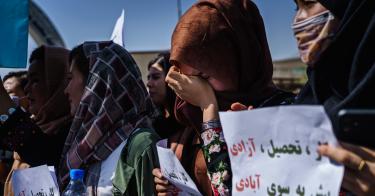Meet the “new Taliban,” same as the old Taliban.
The newly restored masters of Afghanistan are at it once again, killing civilians, carrying out kidnappings, and beating innocents across the country. Women are now segregated in classrooms and covered from head to toe. Peaceful protesters have been attacked and reprisal killings have become commonplace.
One group likely to suffer some of the strongest persecution from the Taliban is Afghanistan‘s Hazara community. The Hazaras are a Shia Islam minority living in the central highlands of Afghanistan in a region referred to as the Hazarajat.
Estimates vary, but it is thought that Hazaras make up between 12% and 20% of Afghanistan‘s population, making them the country’s third-largest ethnic group after Pashtuns and Tajiks. While the Hazaras are little known to most outside of Afghanistan, the heart of their homeland—Bamiyan province—made international news in 2000 when the Taliban blew up the two famous statues of Buddha there.
>>> America Must Stand Up for Fundamental Rights of Afghan Women
Many believe the Hazaras are descendants of Genghis Khan’s army, which swept through the region in the 1220s. The Hazaras are thought to have converted to Shia Islam in the 1500s, when ruled by the Safavid Dynasty.
They are the only significant ethnic group in Afghanistan that does not observe Sunni Islam. Consequently, they have been the subject of persecution for decades.
In the 1990s, the Hazaras were a major power broker in Afghanistan‘s civil war. When the Taliban captured Kabul in 1996, the Hazaras joined forces with the newly created Northern Alliance alongside ethnic Tajik and Uzbek forces.
The war was particularly bloody for the Hazaras. When the Taliban captured the northern stronghold of Mazar-i-Sharif in 1998, they went door to door targeting Hazaras, especially military-age males.
These targeted attacks against the Hazaras eventually spread to other regions of Afghanistan, in particular Bamiyan province. For the Sunni Taliban, there was no room for Shias. They killed Hazaras by the thousands. Many were shot point blank in their homes or had their throats cut in front of relatives. Many more were killed after being packed alive into shipping containers and being left in the sweltering Afghan heat with no water or food.
During the fighting in the 1990s, Iran strongly supported the Hazaras. Tehran sent weekly flights of food, medicine and weapons to regions under their control. At the time, the extremist Shia government in Tehran had little tolerance for the Sunni extremist Taliban movement.
The mullahs in Tehran felt obligated to back the Afghan Shias, and Iran paid a price for this. As part of the Taliban’s pogrom in Mazar-i-Sharif, they murdered eight Iranian diplomats captured inside Iran’s consulate. This incident almost brought the two sides into direct conflict.
Today, the situation remains bleak for the Hazaras. With the Taliban back in power, there have been numerous cases of Hazaras being removed from their homes, threatened with forced marriages, and targeted killings. Moreover, Iran’s role in the current situation is different from the 1990s.
>>> Atomic Ayatollahs Up the Ante on Biden Administration
In recent months Tehran has made very sympathetic statements about the Taliban and has all but welcomed their return to power. This is not surprising. In recent years the Iranians armed certain groups of Taliban to kill and maim U.S. and international forces.
Clearly, any ideological struggle that existed between Iran and the Taliban in the 1990s became less of a priority when dealing with a common enemy: the U.S.
Many Hazaras feel abandoned by the international community and thrown to the wolves by Iran. However, the Hazaras are part of Afghanistan‘s history, culture and people. They are woven into the social fabric of the country and, absent complete genocide by the Taliban, this will remain the case.
But make no mistake. With the Taliban back in power, all minority groups in Afghanistan face dark days ahead. And the darkest of all may be awaiting the Hazaras.
This piece originally The Washington Times




